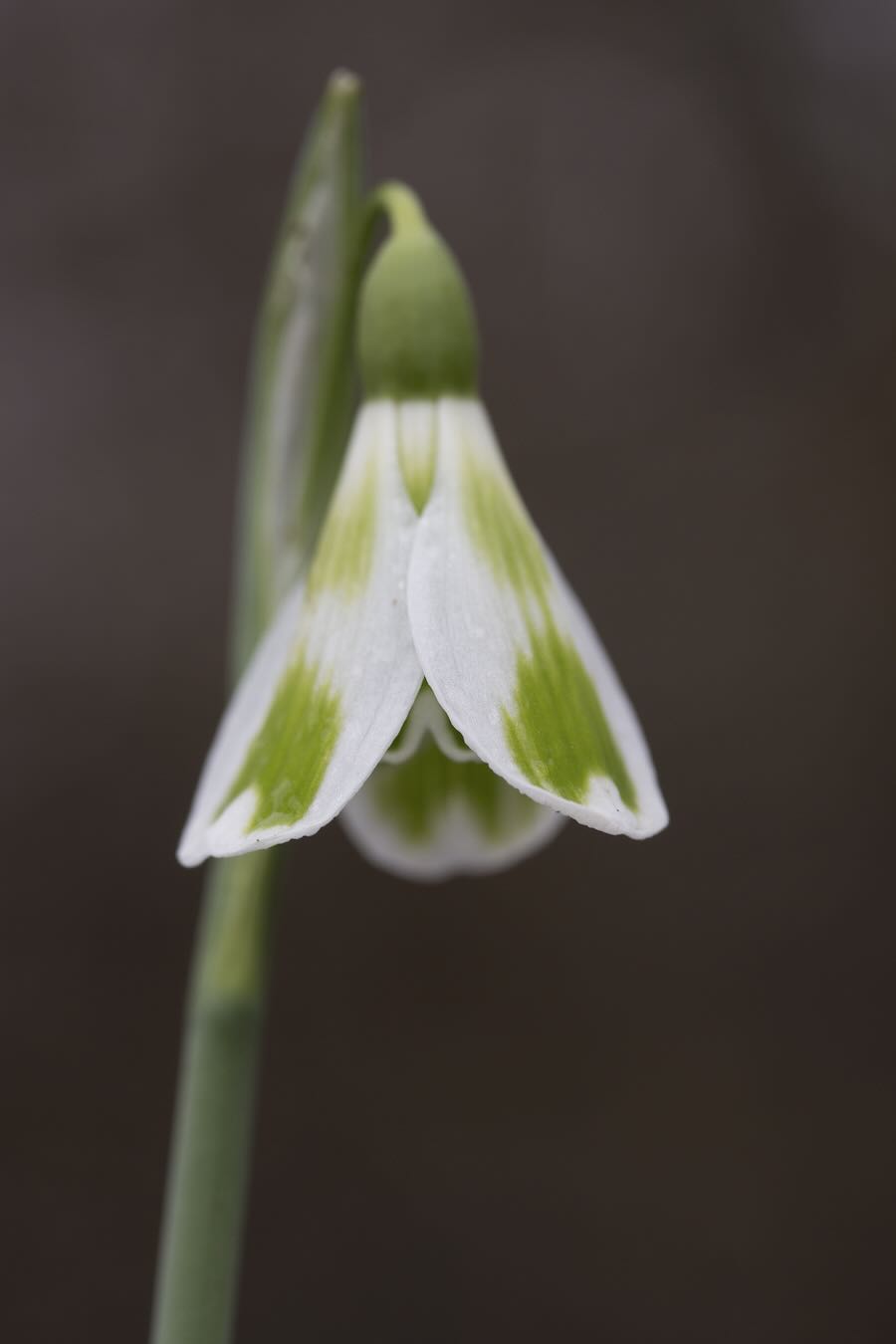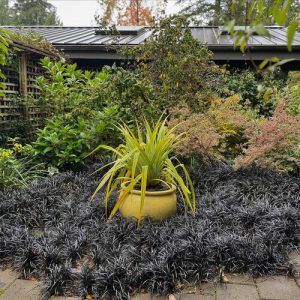
DAVID CULP is a self-professed Galanthophile, a lover and passionate, longtime collector of snowdrops in all their various incarnations. He’s also a host of the annual Galanthus Gala symposium, which happens the first weekend of March in Downingtown, PA, and virtually online, too, for those of us who want to join in without even leaving home, as I did last year, and will again this time around.
David Culp, author of “A Year at Brandywine Cottage,” and also of “The Layered Garden” (affiliate links), gardens on two acres in Downingtown, where among many botanical treasures he grows more than 200 cultivars of Galanthus or snowdrops, proof positive that he is indeed a true Galanthophile.
We talked about snowdrops: how to grow them, and multiply them, and also about his passion for collecting and more.
Plus: Comment in the box near the bottom of the page for a chance to win a copy of his book, “A Year at Brandywine Cottage.”
Read along as you listen to the Jan. 22, 2023 edition of my public-radio show and podcast using the player below. You can subscribe to all future editions on Apple Podcasts (iTunes) or Spotify (and browse my archive of podcasts here).
 snowdrops, with david culp
snowdrops, with david culp
Margaret Roach: Hi, Dave. How are you?
David Culp: Hi, Margaret. I’m fine [laughter].
Margaret: Madman. Madman. Sorry, it’s a madman alert [laughter]. You’ve got a lot of plants over there, kiddo.
David: Indeed. Yeah, I was chuckling. Yes, I am a Galanthophile, proud to say. I let my geek flag wave high.
Margaret: Exactly. So, I don’t know how many years it’s been going on, the Galanthus Gala. So just briefly, what is it? And there’s some great speakers this year, as always, so tell us just briefly what it is.
David: Well, for 20 years, I would go over to England for the RHS winter show, to see hellebores and Galanthus. And then I had this great epiphany that planes fly both ways across the Atlantic. Why can’t the Europeans and Brits come to us? And so I organized the Galanthus Gala in 2017. And as fate would have it, it snowed that day, so we moved it to my meeting house in Downingtown, it’s a 250-year-old Quaker meeting house; I moved it to there, to their schoolhouse. We’ve had vendors and we have speakers, and it’s grown and grown and grown.
I had an interest in Galanthus. It stemmed from my interest in hellebores, winter gardening in particular. Anyone can do a garden in June. [Hellebores and snowdrops, below.]
Margaret: Yes [laughter].

Margaret: Yeah, exactly. Well, it happens to the best of us. Although I have to say, I’ve managed to have a lot of plants, but not a lot of one genus of plants. I don’t know why that… why I mostly escape that. Different people have different psychological attachments or whatever. I’ve got a lot of different plants.
But anyway, so some Galanthus basics. Where are they from? When do they bloom? I mean, how many kinds are there anyway? I mean, how diverse a group is it? I think that I read on your website that the name Galanthus comes from the Greek words for… G-A-L-A for milk, and A-N-T-H-O-S for flower, milk flower, or it looks like drops of milk and so forth. Where are they from?
David: They are from… Let’s see, the Crimean region, or Northern Turkey-
Margaret: So, the Balkans and stuff?
David: The Balkans, all the way up to Southern Europe. They’ve migrated. During the Crimean war, the British soldiers would send snowdrops back to England. They were first recorded in, I think, the 1500s, in Gerard’s Herball book, but they are not native. They’ve since naturalized all around Europe and England.
Margaret: O.K. And in terms of… So again, you’re sort of mid-Atlantic, so you’re in Pennsylvania, not far from famous Longwood Gardens and so forth. So, when did they bloom for you? You have 200 or something kinds. What’s your bloom season, the range of them?
David: You know Margaret, I like to take the challenge cup [laughter]. So, my Galanthus started blooming in October. They bloom all the way through the winter, there are hundreds blooming right now, but we’re not in peak Galanthus season, mind you. They are earlier this year, thank you, not thank you, global warming.
Margaret: Yes.
David: Lots blooming right now. We’re going to have cold weather this week, but they can take it. That’s one of the things I like about them, is they can take the rigors of winter and still keep on blooming.
So they go right through the winter, all the way till April. And when people kind of kid me and say “Galanthus,” and I just stop and go, “What’s blooming in your garden right now?” That usually gives me pause, and I can say, “I have hundreds of…” And I need chlorophyll in the wintertime. I don’t know about you, but I need something green.
Margaret: Right. So, there are either species or varieties for a lot of different zones. I think on your website, again, it says 2-9, but the sweet spot is zones 4-7-ish or so, for these bulbs and…
David: Probably. My friends up in northern New York, in colder areas, they probably are growing lots of Galanthus nivalis, which are very popular in Germany and northern Europe right now. There’s a lot of breeding work being done there. So what I… I like nivalis, I grow a lot of them, they’ve naturalized here in southeastern Pennsylvania, New York. They’re the one that’s naturalized the most in the U.S.
I also like the Galanthus elwesii, because it’s a larger flower and it blooms earlier. But then there’s a whole host of hybrids. There’s four different basically species that make up the genus Galanthus, but the bulk of my collection is nivalis, gracilis, elwesii, the hybrids. But like any Galanthophile, the truth is, you’ve got to have them all, and you soon learn to work with what works with you, and go with those particular species.
Margaret: Right. Right. So, when you were talking about how you’ve had some blooming since October, and there’ll be ones blooming through April, you don’t mean the same exact flower, of course. You mean this continuing, this succession of this genus, because you’ve planted different types, you have this succession, this continuing wave of them. And we gardeners who are not Galanthophiles yet [laughter], we see them in the fall bulb catalogs, I believe. That’s when they’re sold mostly. Is that correct?

They are in the Amaryllidaceae family, and now people are glazing over. That’s important, though, because with Amaryllidaceae you automatically go: “deer-proof.” So, they’re deer-proof. The other thing about the Amaryllis family is that they only put roots out once a year. So if you damage the roots when you’re transplanting them, they’ve lost the ability to take up that much more nutrients. So, you’re safe when they’re dormant, but even better if they’re in a container and you buy them in the green.
Did that confuse you?
Margaret: No, no. No, I get it. And when we say “in the green,” we mean that it’s up and growing, so to speak; it’s a transplant.
David: Yeah. Yeah.

David: My garden Brandywine Cottage, is… I used not to label anything. The only thing I labeled in my garden is my Galanthus collection. I don’t know if I’ve risen to new heights or sunk to new lows. I do label my Galanthus, because I’d be lost without them.
An unlabeled Galanthus, if you don’t know what it is, is just a pretty Galanthus. And that’s O.K., but if you’re a serious collector of anything, whether it be art glass, you got to know the provenance of it.
Margaret: Yes. So, I look at the lists from collectors who sell them, or some of the sources that Galanthophiles would shop at, not your basic mail-order bulb catalog, mass-market bulb catalog, which has a few kinds. And I see some for $30, which I assume is for a bulb, and some for close to $500 for a bulb. So, some of them are really, really, really expensive.
And so if I splurge on even a $30 bulb, if I splurge on one, what happens? What is that little creature doing? How long does it… How does it multiply? Does it multiply only underground? Do they self-sow? What’s their method of becoming more than one in my garden?
David: Well, both.
Margaret: O.K.
David: And I’ve confessed that I’ve paid maybe way too much for a single bulb of Galanthus. It’s kind of like Tulip Mania right now. They fetch huge prices from $1,400 down to $30. And I offer just basic elwesii in the pot, to the very expensive ones at my table, and at the Gala, you’ll see them all price ranges. You buy what you’re willing to gamble and plant in the ground.
And people laugh and say, “You paid that much for a bulb?” And I said, “Well, how’s your 401k done? My investment in that bulb usually doubles within one year.”
Margaret: Oh!
David: So, you can expect that to probably double within a year, maybe two at the most. But if it’s damaged, the roots are damaged, it might take another year for it to pull up its socks and bloom for you. But it reliably increases very slowly, and makes a large clump.
It does self-seed. I’m afraid I’ll never have a really tidy garden again, because I let my Galanthus go, hoping that they’ll seed around. And you can’t mulch… I don’t mulch, anyhow, I use leaf mold on my garden, but they will self-sow around, and you get some interesting hybrids. When you have this many cultivars intermingling and having wine and doing what in the middle of the night [laughter], you’re going to have some interesting hybrids.
Margaret: So they’re not just botanical Bitcoin, they’re also sexy creatures [laughter].
David: They are.
Margaret: So, you’re known—and I mentioned earlier in the introduction that one of your books that you’ve written is called “The Layered Garden”—and so you’re known design-wise as a proponent of the technique of layering plants. Not just sticking one thing here and one thing there and so forth, and having this succession and complexity of beauty in the garden unfolding. How did Galanthus fit into that strategy? So, where did they go and where do they belong in the garden?
David: Well, they start the year. That’s why we have the Gala in March. It’s like the kickoff of spring. As soon as my garden starts blooming with the Galanthus and the Crocus tommasinianus and the hellebores, it’s spring. I don’t go by the exact calendar. I let my garden tell me what season it is; I watch it. So, my garden starts blooming here in zone… I think we’re still… Who knows? 6b or 7. Again, the global warming factor makes it hard. We haven’t had snow here in Philadelphia in two years, we’re expecting our first measurable snowfall tomorrow.
Margaret: Yes. I saw that in the paper. Yes.

Margaret: Do Galanthus do better with more or less light, or what are some of the good niches within the garden, light-wise and other condition-wise, that they like?
David: Shade is preferred. You can push them more towards full sun, you might want to give them a little bit of shade in the summertime. A lot of the species that are more southerly in their distribution actually like more sun, I would say, like reginae-olgae, which is named after the queen of Greece. She needs more sun, that one needs more sun, because it’s native to Greece.
Margaret: I see.
David: So I have them in full sun. What Galanthus tend not to like is overly moist soils, like soggy soils. The one that’s probably the more tolerant of moisture-retentive—I’m saying tolerant, not -proof—might be nivalis, but I would stay away from overly wet, boggy soils when it comes to Galanthus.
Margaret: I think bulbs in general, and not all, but most, I feel that way, that they don’t want to be in a sump.
David: They don’t.
Margaret: Yeah. And if I had a good size group of something… The only ones I really have are the two most familiar that you mentioned, and even here in what used to be zone 5b until the other day [laughter], when they announced that it was 6a, with the unusually mild winter we had until this week, they were starting to come up under the leaf litter, they were starting to push. And even neighbors had a couple flowers here and there.
So, if I get a good-sized clump, and I want to say divide them and put some elsewhere, do I do it when they’re “in the green”? Do I do it when they’re up and running? Is there a good time?
David: I do. I’m a bit pragmatic. The optimal time is when they start going dormant, when the leaves start to yellow. But the truth is, Margaret, I do it when they’re in the full green, and I usually… Well, I’m always in a hurry, so I’ll take a clump, maybe a sizable clump, and I divide it in thirds. I divide it, leave one clump where it was, I put two other clumps elsewhere.
Immediately, no matter if it’s raining out, you want to water it in, to make sure that the soil has contact with the roots. That’s important. But it’s kind of like insurance, too. If something happens to one clump, you still have two more elsewhere. If you just have one clump that’s prized, and that clump for some reason disappears… I think dividing not only gives you more for the garden, but also serves as a kind of insurance, that you still have your prized bulbs available.
Margaret: Right. I was looking through your list, you have a list of ones that, as you said, that they turned out to be a good investment, because you can also sell some, as you get more and more and more of certain ones.
And there were some familiar names, you just mentioned one that was named for a Greek queen or something, but I saw that there was one that you recommend, and it wasn’t a super-expensive one. It’s called Bertram Anderson. And it’s funny, because in the years that I’ve grown plants, I’ve had two other plants named for Bertram Anderson [laughter], a Pulmonaria and a Sedum. So, he must’ve been some great gardener, Bertram Anderson.

Margaret: Well, it was fun, as I said, looking at the list. It’s like, ooh, I just want to find out who all those people and all those places that all the varieties are named for, because you’d get this whole rich history by doing that, working backwards from that list of named cultivars of Galanthus. You’d get this whole history of our obsession with gardening over the centuries. I think he was in the Cotswolds region, right, Bertram Anderson?
David: That’s a big area of Galanthophiles. There’s a lot of them in the Cotswolds. They’re basically a two-hour… I hesitate to say that, because they’re spread everywhere, but usually when I go over, it’s within a two-hour push outside of London. But there are great Galanthophiles in Ireland. They have Galanthus shows and sales in Germany, in Belgium. I mean, it’s sweeping Europe right now.
Margaret: Mm-hmm. So, in all of these varieties, what are just… I know it’s hard to… I feel like I have to get down on the ground and crawl around and look closely at them, because these are not up in your face kind of, or it’s not as big as a knee-high red tulip or something. You have to really look closely at the subtleties. But some of them are more frilly, like almost double, I guess, the flowers, and some have more green edging. Are those the differences… What are you looking at as a collector to add to your collections?
David: Well, I don’t know of a genus that is… One of the things that appeals to me about snowdrops are their utter simplicity. But then again, I don’t know of a genus that’s so highly nuanced. It’s about how long the claw is, how they taper at the end, how the green tips… How the shading is: Is it a blotch, is it striped? It’s all about these subtleties. Your eye, once it is trained to look at subtleties, whether it be Galanthus or any other plant in the garden, you become a better gardener as you start looking at subtleties.
That being said, I’ve seen gardens just have one species, like Painswick in England, which is all I think nivalis, and it’s a very popular and very effective landscape. But it’s looking at those details that sharpens your eye. And the other thing about Galanthus, it’s a time you can gather with friends like at the gala, and not have any guilt feelings about leaving your garden, because nothing else is going on. You can actually talk with fellow gardeners at that time of the year. It’s kind of a gardener’s sport, if you will.
Margaret: Yeah. So, let’s talk about the Gala. I was excited to see that you’re having… I mean, you have presenters, people who do talks, and again, they’re going to be broadcast virtually also, so people can buy, as I did, a virtual ticket, as well as attend in person in Downingtown, Pa. But like Nancy Goodwin, one of the… I mean, I remember a million years ago, the first time I went to her Southeastern garden, and just the astonishment of what she had accomplished. So, there are some really great speakers, so tell us a little bit about what’s going to go on, whether in person or virtually at the gala.
David: We start Friday with the virtual happy hour, and it’s kind of… Social activity is part of being a Galanthophile. There’s a social aspect to it. So we have a trivia game which is great fun, because… I’ll tell you a little secret. Because it’s five hours… We’re ahead of England five hours, so they’ve always gone through cocktail time by the time we have the happy hour, and you can see it sometimes in their responses [laughter], which is great fun. We have the happy hour, and we have Nancy Goodwin speaking, and I’m just honored to introduce her. She’s, as you said, an iconic garden in the South.
A lot of gardeners in the South think that Galanthus aren’t hardy for them, because it’s too warm. Well, I just want to point to Nancy Goodwin, who’s been doing Galanthus in her garden for 30 years. She’s known right now with her Galanthus collection for having the winter walk. She has a lot of fall-blooming Galanthus in her garden. But I just wanted to have her speak because she’s such a good gardener, and has been doing Galanthus, and help dispel that myth that you can’t grow them in the South. I actually have a busload coming from Tennessee to the gala this year.
Margaret: Oh, great.
David: And they’ve been coming several years, we have several busloads coming to the gala. Then on Saturday, we have the curator of Utrecht Gardens speaking on DNA tracing in snowdrops, to make sure how the Galanthus have moved from the Mediterranean upwards through Europe. They’re actually doing DNA tracing to make sure they have the right cultivars and species in the garden, that they’re historically correct as well. I think that’s fascinating, that we’ve moved in that direction, not just in Galanthus but plant-wide. I think DNA tracing is going to change the way Linnaean nomenclature is today.
And then we have the director of the Gothenburg Botanical Garden in Sweden, which is the largest bulb collection in the world.
Margaret: Wow.
David: Not just the United States. But he’s going to be talking about his love of Galanthus, and more importantly I think, just as importantly, are the companion plants, the companion bulbs to bloom with them, so it’s not just one genus, it’s about making a garden, Margaret. About…
Margaret: Speaking of layering [laughter].
David: It’s about making a garden, and what goes with that plant? Yes. That’s right; thank you.
Margaret: Well, David Culp, we’re almost basically out of time. But I always have fun, as people could tell, because I was cackling throughout, talking to you.
David: You should have fun.
Margaret: A fellow plant nut of… a longtime plant nut like me. So, thank you so much, and I’ll talk to you again soon, I hope.
David: Thank you, Margaret. I look forward to seeing you soon, and everyone at the Gala. Happy gardening.
more on galanthus from david culp
enter to win ‘a year at brandywine cottage’
I’LL BUY A COPY of “A Year at Brandywine Cottage” by David Culp for one lucky reader. All you have to do to enter is answer this question in the comments box below:
Any snowdrops poking up soon at your place, and if so do you know which ones?
No answer, or feeling shy? Just say something like “count me in” and I will, but a reply is even better. I’ll pick a random winner after entries close at midnight Tuesday, Jan. 30, 2024. Good luck to all.
(Disclosure: As an Amazon Associate I earn from qualifying purchases.)
prefer the podcast version of the show?

 snowdrops, with david culp
snowdrops, with david culp





